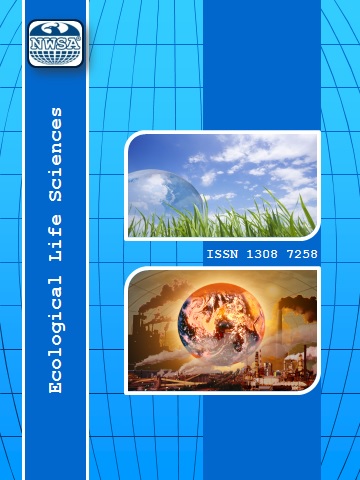References
[1] Welsh, S.L., Atwood, N.D., Goodrich, S., and Higgins, L.C., (1987). Division magnoliophyta class liliopsida. Great Basin Naturalist Memoirs, 9:143-144.
[2] Kozhova, O.M. and Izhboldina, L.A., (1992). Spread of Elodea canadensisin lake baikal. Hydrobiologia, 239:43-52. https://doi.org/10.1007/BF00027528
[3] raj-Krzyc, N., Germ M., Urbanc-Bercyc O., Kuhar, U., Janauer, G.A., and Gabercyk, A., (2007). The quality of the aquatic environment and macrophytes of karstic watercourses. Plant Ecology, 192:107118. https://doi.org/10.1007/s11258-006-9230-4
[4] Larson, D. and Willén, E., (2007). The relationship between biodiversity and invasibility in central swedish lakes invaded by elodea species, 2:423-433. In: Gherardi, F., (Editor). Ysveç: Invading Nature-Springer Series In Invasion Ecology. https://doi.org/10.1007/978-1-4020-6029-8_23
[5] Thyébaut, G., (2007). Non-indigenous aquatic and semiaquatic plant species in France. 2:209229. In: Gherardi G (Editor). Fransa: Invading Nature-Springer Series In Invasion Ecology Book Series. https://doi.org/10.1007/978-1-4020-6029-8_11
[6] Cook, C.D.K., (1996). Aquatic plant book. The Netherlands: SPB Academic Publishing.
[7] Hérault, B., Bornet, A., and Trémolyères, M., (2008). Redundancy and Niche differentiation among the European Invasive Elodea Species. Biological Invasions, 10:10991107. https://doi.org/10.1007/s10530-007-9187-9
[8] Kesici, E., Gülle, Y. ve Turna, Y.Y., (2009). E?irdir Gölünde Elodea canadensis Michauxin ilk bildirimi ve istilasy üzerine bir ara?tyrma. SDÜ Fen Dergisi, 4(2):120-1.
[9] Davis, P.H., (1984). Flora of Turkey and the East Aegean Islands. Edinburgh: Edinburgh University, 8:633.
[10] Altynyar, G., (1988). Su yabancy otlary. Bayyndyrlyk ve Yskân Bakanly?y, Ankara: DSY Genel Müdürlü?ü Y?letme ve Bakym Dairesi Ba?kanly?y.
[11] Seçmen, Ö. ve Leblebici, E., (1997). Türkiye sulak alan bitkileri ve bitki örtüsü. Bornova/Yzmir: Ege Üniversitesi Fen Fakültesi Yayynlary, 158:800.
[12] Altuner, Z. ve Gürbüz, H., (1991). Karasu (Fyrat) Nehrinin epipelik ve epifitik algleri üzerine bir ara?tyrma. Doga, Turkish Journal of Botany, 15:253-267.
[13] ?en, B. ve Pala, G., (2001). Çami?gezek bölgesi (Keban Baraj Gölü)ndeki Potamogeton perfoliatus L. üzerindeki epifitik algler. XI. Ulusal Su Ürünleri Sempozyumu, Hatay, ss:206-215.
[14] Albay, M. and Aykulu, G., (2002). Invertebrate grazer-epiphytic algae interactions on submerged macrophytes in a mesotrophic Turkish Lake. Ege Üniversitesi Su Ürünleri Dergisi, 19(1):247-258.
[15] Yüce, A. ve Ertan, O.Ö., (2001). Kovada Gölü epifitik algleri (Isparta-Türkiye). XI. Ulusal Su Ürünleri Sempozyumu, Hatay, ss:216-224.
[16] Pala, G., (2014). Hazar Gölü (Suluçayyr Düzü) epifitik diyatome florasy. Fyrat Üniversitesi Fen Bilimleri Dergisi, 26(1):45-51.
[17] Soylu, E.N., Mara?lyo?lu, F., and Gönülol, A., (2011). Liman Gölü (Bafra-Samsun) epifitik diyatome florasy. Ekoloji, (20)79:57-62.
[18] Mara?lyo?lu, F., Soylu, E.N. ve Gönülol, A., (2007). Seasonal variations and occurrence of epiphytic diatom assemblages on mats of Cladophora glomerata in Lake Ladik, Samsun, Turkey. Cryptogamia Algologia, 28:373-384.
[19] Fakyo?lu, Ö., Atamanalp, M., ?enel, M., ?ensurat, T. ve Arslan, H., (2012). Pulur Çayy epilitik ve epifitik diyatomeleri. Süleyman Demirel Üniversitesi E?ridir Su Ürünleri Fakültesi Dergisi, 8(1):1-8.
[20] Akköz, C., Kucukoduk, M., Obali, O., Ozturk, C. ve Dogan, H.H., (2000). Be?göz Lake (Sarayönü/Konya) alg flora: epilithic and epiphytic algae. Selçuk University, Journal of Engineering, Science and Technology, 1(16):5-12.
[21] Özer, G. ve Pala, G., (2014). Elazy? ili çevresindeki bazy su kaynaklaryndan toplanan Lemna minör (L.)ün epifitik algleri. Ystanbul Üniversitesi Su Ürünleri Dergisi, 29:1.
[22] Pala, G. ve Tepe, R., (2016). Karkamy? Baraj Gölü (Gaziantep)nden toplanan Potamogeton lucens L.in epifitik algleri. Fyrat Üniversitesi Fen Bilimleri Dergisi, 28(1):29-37.
[23] Sönmez, F., Kutlu, B., and Sesli, A., (2017). Spatial and temporal distribution of phytoplankton in Karkamy? Dam Lake (?anlyurfa/Turkey). Fresenius Environmental Bülletin, 26(10):6234-6245.
[24] URL-1: https://tr.wikipedia.org/wiki/Karkam%C4%B1%C5%9F_Baraj%C4%B1_ve_Hidroelektrik_Santrali
[25] Round, F.E., (1953). An investigon of two Bentic Algal communities in Malharm Tarn, Yorkshire. Journal of Ecology, 41:97-174. https://doi.org/10.2307/2257108.
[26] Patrick, R. ve Reimer, C.W., (1966). The diatoms of the united states, exclusive of Alaska and Hawaii. Monographs of The Academy of National Sciens of Philandephia, 13:688.
[27] Patrick, R. and Reimer, C.W., (1975). The Diatoms of the United States. 2. Phyladelphia: Academy of Natural Sciences of Philadelphia.
[28] Bourelly, P., (1968). Les Algues Deau Douce Algues Jaunes et Brunes. Paris: N. Baubes (Edit.).
[29] Germain, H., (1981). Flora Des Diatomees Diatomophycees. Paris: Societe Nouvelle Des Editions Boubee.
[30] Grimes, J. and Rushforth, S.R., (1982). Diatoms of recent bottom sediments of Utah Lake. Bibliotheca Phycologica Germany, 55:1-179.
[31] Sørensen, T., (1948). A method of establishing groups of equal amplitude in plant sociology based on similarity of species and its application to analyses of the vegetation on danish commons. Kongelige Danske Videnskabernes Selskab, 5(4):134.
[32] Yyldyz, K., (1985). Altynapa Baraj Gölü alg topluluklary üzerinde ara?tyrmalar kysym I: fitoplankton toplulu?u. Do?a Bilimleri Dergisi-A2, 9(2):419-427.
[33] Gönülol, A., (1985). Studies on The Phytoplankton of The Bayyndyr Dam Lake. Communications, (3):21-38.
[34] Gönülol, A., (1985). Çubuk-I Baraj Gölü Algleri Üzerine Ara?tyrmalar II. Kyyy Bölgesi Alglerinin Kompozisyonu ve Mevsimsel De?i?imi. Do?a Bilimleri Dergisi, 9(2):253-268.
[35] Pala (Toprak), G., (2007). Keban Baraj Gölünün Gülü?kür kesimindeki planktonik algler ve mevsimsel de?i?imleri, II- Bacillariophyta. Fyrat Üniversitesi Fen ve Mühendislik Bilimleri Dergisi, 19:23-32.
[36] Obaly, O., (1984). Mogan Gölü fitoplanktonunun mevsimsel de?i?imi. Do?a Bilimleri Dergisi, (8):91-104.
[37] Kairesalo, T. ve Koskimes, I., (1985). Vernal succession of littoral and nearshore phytoplankton: significance of interchange between the two communities. Aqua Fennica, 15(1):115-126.
[38] Round, F.E., (1981). The Ecology of Algae. U.S.A.: Cambridge University pres., 653.
[39] Rodhe, W., (1948). Environmental requiremets of freshwater phytoplankton algae. Experimental studies in the ecology of phytoplankton. Environmental Science, 10:11-49.
[40] Hutchinson, G.E., (1967). A Treatise on limnology. Introduction to Lake Biology and the Limnoplankton, 14(3). David G. Frey (Edit.) New York: John Wiley&Sons.
[41] Gönülol, A. ve Çomak, Ö., (1990). Bafra Balyk Gölleri (Balyk Gölü; Uzun Göl) fitoplanktonu üzerinde floristik ara?tyrmalar, I- Cyanophyta. Doga, Turkish Journal of Botany, 16:223-245.
[42] Pala (Toprak), G., (2001). Keban Baraj Gölünün Gülü?kür kesimindeki algler ve mevsimsel de?i?imleri. (Yayymlanmy? Doktora tezi), Elazy?: Fyrat Üniversitesi Fen Bilimleri Enstitüsü.
 +90(535) 849 84 68
+90(535) 849 84 68 nwsa.akademi@hotmail.com
nwsa.akademi@hotmail.com Fırat Akademi Samsun-Türkiye
Fırat Akademi Samsun-Türkiye
